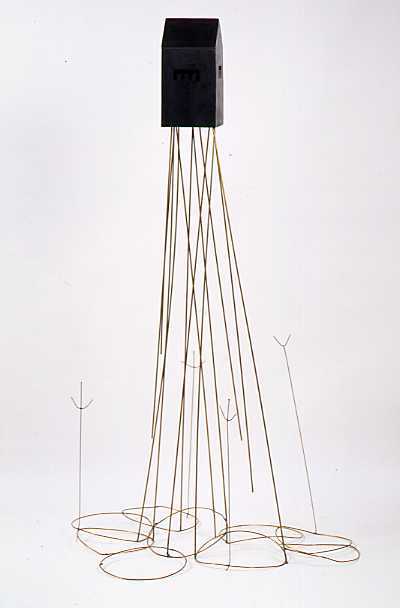OF AIR AND WATER
Of the four elements -according to the revelation given to the lisdean sculptor-, air and water, by their transcendent nature, are opposed, although, by the very essence of the things that exist in the square surface they delimit, it is in that same contradiction where they find their raison d’être and where they are realized. The air transposed into ether, the exclusive water vehicle of fertilization. That revives the flame, propagates the energy; it extinguishes it and at the same time serves its materialization, the concretion of what is idea and desire. Everything converges in everything, and when art intervenes, nature itself is transmuted and the unapprehensible becomes tactile and the liquid, solid.
In Carmen Baena’s work, this thaumaturgical action is developed with the naturalness of one who, certain of what he does, makes the difficult easy, coherent to the paper assigned to the materials that, without losing their prerogatives -the ones that belong to them by their origin-, go on to represent it according to the sculptor’s guidelines, thus becoming a creator not of circumstances, but of contents.
The air envelops, contains, penetrates that which in its solidity, in its external appearance closes its doors, its openings, and presents itself as solid, compact, in a single piece, solid, whether in wood, paraffin or polyester resin: are the “Rain Houses” – opposite to the “Wind Houses”, because they allow the air to circulate inside them – from which come out – again by “magic” – the steel threads in a projection equivalent to the slowing down of the fall of a drop of water or to the sum of many that remain united in the time of the art. Once again, we are confronted with a “reality” which, starting from what we consider “reality itself”, separates from it insofar as it only responds to the conception of the author who can, using matter, give it an even opposite value.

The water that falls in a rigid cascade from an invisible fountain – and intuitive – or from a translucent interior – that implies the unveiling of the intimacy of the sculptor, but that continues conserving the aura of mystery – and its connection with the nature represented in the arboreal forms, as a symbol of an integrating origin that is yearned for and that transcends in the gold of some branches – the “golden branch” of knowledge, an arcane that must be recovered and “opened” so that its drops of living sap counteract the drought of the rationalist excess. Drops that when they fall also branch into sonorous threads by the action of the wind -the dynamic container air- or by the human contact, invitation to the active participation, because Carmen Baena knows of the importance of the senses.
The tree, as a symbol of the primitive, is also individualized in a demonstration of its importance in the ideological support of the sculptor, and in the series “Trees” (green, frost, black) claim the protagonism impostados in the plane. But, as it happens in the rest of his work, including the blocks of stone or marble in which the acid or the chisel affect the surface “vegetalizing it”, is not a consequence of its “specific” process, it comes from the “creative action”. of the sculptural labor that “builds” a tree-his “tree”-impossible to find and, nevertheless, with the enigmatic force that gives him the intention, that confers him the art.
Air and water-“of air and water”-elements on which he bases the construction of a personal world, his own, clearly represented in what is the nucleus of almost all his work, in those empty and penetrated houses of air and nature, or massive ones- in the appearance impossible to penetrate-and, nevertheless, containing in du interior the hope. From there, from the redoubt where idea, thought and feeling try to remain uncontaminated, Carmen Baena expands by the “air” her feeling, she dilutes it in the water so that it soaked, not the barren earth where the dry branches of the forgetfulness lie -recovered by her action-, but to those who contemplate them and perceive in them the breeze and the humidity that make retake the desire of investigation of return to the simplicity of the origin, there where the mystery was not explained: it was lived.
Pedro Alberto Cruz Fernéndez

